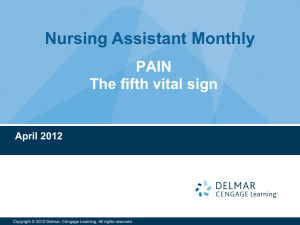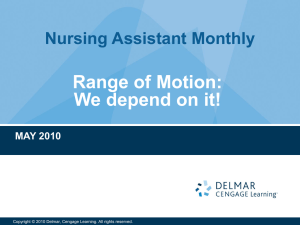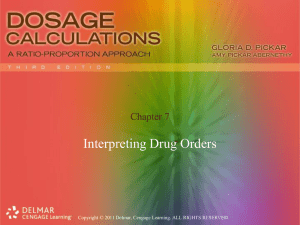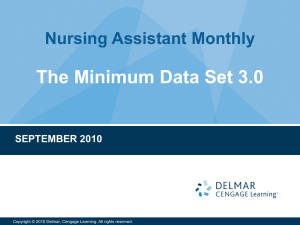CHAPER 4: ICD-9-CM CODING GUIDELINES
advertisement
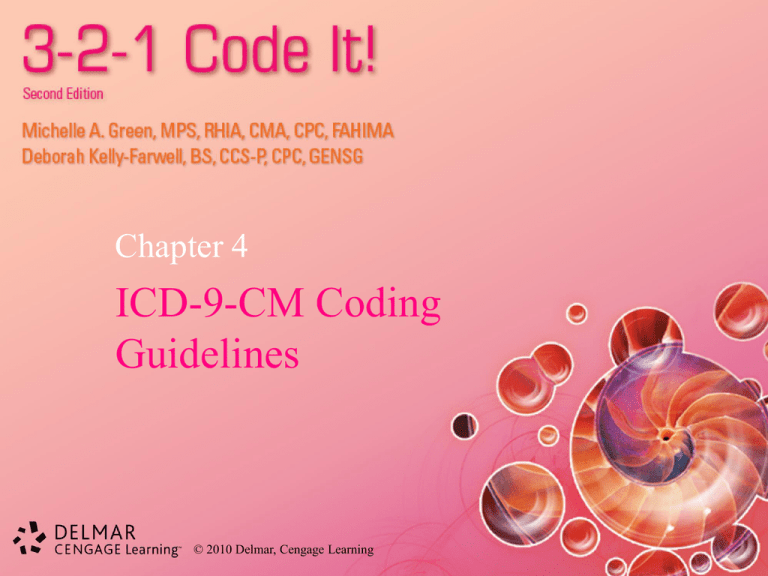
Chapter 4 ICD-9-CM Coding Guidelines © 2010 Delmar, Cengage Learning ICD-9-CM Official Guidelines for Coding and Reporting • Rules developed by the cooperating parties for the ICD-9-CM to accompany and complement the official conventions and instructions provided within ICD-9-CM • Companion to ICD-9-CM © 2010 Delmar, Cengage Learning (continued) ICD-9-CM Official Guidelines for Coding and Reporting • Cooperating parties consist of: – – – – American Hospital Association (AHA) AHIMA CMS NCHS © 2010 Delmar, Cengage Learning HIPAA Alert! • HIPAA regulations require providers and third-party payers to adhere to ICD-9-CM Official Guidelines for Coding and Reporting. • A violation of coding guidelines is a violation of HIPAA. © 2010 Delmar, Cengage Learning Official Guidelines for Coding and Reporting • Four sections: – – – – Section I Section II Section III Section IV © 2010 Delmar, Cengage Learning Historical Perspective • Bertillon International Statistical Classification of Causes of Death • International Classification of Diseases (ICD) • ICD-9-CM • ICD-10-CM and ICD-10-PCS (future) © 2010 Delmar, Cengage Learning General Guidelines • Use both the ICD-9-CM Index to Diseases and the Tabular List of Diseases. • Locate term in the Index to Diseases first, and verify the code in the Tabular List of Diseases. • Assign the highest level of digits available. © 2010 Delmar, Cengage Learning Guidelines • Signs and symptoms that are integral to the disease should not be assigned as additional codes. • The etiology and manifestation convention requires two codes to be reported to completely describe a single condition. © 2010 Delmar, Cengage Learning (continued) Guidelines • Multiple coding – Use additional code – Code first – If applicable, code any causal condition first • Acute (or subacute) and chronic conditions • Combination code versus multiple code © 2010 Delmar, Cengage Learning Late Effect • Residual condition that develops after acute phase of illness or injury has ended – No time limit on reporting • Combination code assigned • For example, painful cicatrix following severe burn to the elbow or left-sided paralysis due to previous cerebrovascular accident (CVA) © 2010 Delmar, Cengage Learning General Procedure Guidelines • Based on anatomy rather than surgical specialty • Numeric codes • Use both Index to Procedures and Tabular List of Procedures © 2010 Delmar, Cengage Learning (continued) General Procedure Guidelines • Index to Procedures main terms organized in alphabetic order according to type of procedure • Report codes using highest number of digits available • — omit code © 2010 Delmar, Cengage Learning (continued) General Procedure Guidelines • Common key terms: – – – – – – Application Closure Correction Destruction Division Incision © 2010 Delmar, Cengage Learning – – – – – – Insertion Operation Procedure Release Removal Repair (continued) General Procedure Guidelines • Common key terms: – – – – – – Resection Revision Suture Test Therapy Transfer © 2010 Delmar, Cengage Learning (continued) General Procedure Guidelines • • • • • • • Combination codes Multiple codes And/Or Open procedure versus closed procedure Endoscopic procedures Biopsies Canceled surgery © 2010 Delmar, Cengage Learning Chapter-Specific Guidelines • • • • • Principal diagnosis Principal procedure Secondary diagnoses Secondary procedures First-listed diagnosis © 2010 Delmar, Cengage Learning Chapter 1: Infectious and Parasitic Diseases • • • • 001–139 Organisms Infections “Supplemental Classification of Factors Influencing Health Status and Contact with Health Services” • Human immunodeficiency virus (HIV) © 2010 Delmar, Cengage Learning HIV Positive Status • Key terms: – – – – – HIV disease HIV infection HIV infected HIV positive Acquired immune deficiency syndrome (AIDS) © 2010 Delmar, Cengage Learning HIV • HIV-related conditions and opportunistic infections • Sequence HIV code (042) first and then opportunistic infection code • Sequencing of HIV codes with admission for unrelated condition © 2010 Delmar, Cengage Learning (continued) HIV • Asymptomatic HIV • Inconclusive HIV serology © 2010 Delmar, Cengage Learning Chapter 2: Neoplasms • 140–239 • Neoplasm – “New growths or tumors in which cell reproduction is out of control” • Benign • Malignant © 2010 Delmar, Cengage Learning (continued) Chapter 2: Neoplasms • Six classifications: – – – – – – Primary malignancy Secondary malignancy Carcinoma (CA) in situ Benign Uncertain behavior Unspecified nature © 2010 Delmar, Cengage Learning (continued) Chapter 2: Neoplasms • Contiguous sites (overlapping sites) • Re-excision of tumors © 2010 Delmar, Cengage Learning Chapter 3: Endocrine, Nutritional, and Metabolic Diseases and Immunity Disorders • 240–279 • Diabetes mellitus – Type I • Patient’s body unable to produce insulin – Type II • Patient’s body unable to properly use insulin produced © 2010 Delmar, Cengage Learning Chapter 4: Diseases of the Blood and Blood-Forming Organs • • • • • • • 280–289 Hematopoiesis Anemia Red cell volume Hemoglobin content Shape (morphology) Purpura © 2010 Delmar, Cengage Learning Chapter 5: Mental Disorders • 290–319 • WHO guidelines: – When classifying behavioral disorders, organically based illnesses are reported before functional illnesses. – Within a functional group, classify disorders as psychoses, neuroses, personality disorders, and others. © 2010 Delmar, Cengage Learning (continued) Chapter 5: Mental Disorders • WHO guidelines: – When coding mental illnesses associated with physical conditions, assign as many codes as necessary to fully describe the clinical picture. © 2010 Delmar, Cengage Learning Chapter 6: Nervous System and Sense Organs • 320–389 • Nervous system, including meninges • Central nervous system – Brain – Spinal cord • Peripheral nervous system © 2010 Delmar, Cengage Learning Chapter 7: Circulatory System • 390–459 • Hypertension, hypertensive table – Malignant (accelerated) – Benign – Unspecified • Cerebral infarction, stroke, CVA • Late effects of cerebrovascular disease • Myocardial infarction © 2010 Delmar, Cengage Learning Chapter 8: Respiratory System • 460–519 • Nose, sinuses, pharynx, larynx, trachea, bronchi, and lungs • Chronic obstructive pulmonary disease – Refer to main term “obstruction” • Pneumonia • Asthma (status asthmaticus) • Acute exacerbation © 2010 Delmar, Cengage Learning Chapter 9: Digestive System • 520–579 • Major digestive organs include pharynx, esophagus, stomach, and intestines • Accessory (secondary) organs include salivary and parotid glands, jaw, and teeth • Structures that support the digestive process are gallbladder, pancreas, and liver © 2010 Delmar, Cengage Learning Chapter 10: Genitourinary System • • • • 580–629 Chronic kidney disease (CKD) Kidney transplant status (V42.0) CKD with other conditions © 2010 Delmar, Cengage Learning Chapter 11: Pregnancy, Childbirth, and Puerperium • 630–677 • Conditions occurring during pregnancy, childbirth, and six weeks immediately following childbirth • Never report these codes on baby’s record • Outcome of delivery (V27.0–V27.9) © 2010 Delmar, Cengage Learning (continued) Chapter 11: Pregnancy, Childbirth, and Puerperium • 630–633 (ectopic or molar pregnancy) • 639 (complications following abortion and ectopic or molar pregnancy) • Fifth digits to identify abortive stage – Unspecified (0) – Incomplete (1) – Complete (2) © 2010 Delmar, Cengage Learning (continued) Chapter 11: Pregnancy, Childbirth, and Puerperium • 640–648 (complications related to pregnancy) • 650 (normal delivery) – Minimal or no assistance – Episiotomy permitted – Fetal manipulation (e.g., use of forceps) not permitted © 2010 Delmar, Cengage Learning (continued) Chapter 11: Pregnancy, Childbirth, and Puerperium • Fifth digit required for current episode of care – Unspecified as to episode of care (0) – Delivered with or without mention of antepartum condition (1) – Delivered with mention of postpartum complication (2) – Antepartum condition or complication (3) – Postpartum condition or complication (4) © 2010 Delmar, Cengage Learning Chapter 12: Skin and Subcutaneous Tissue • 680–709 • Epidermis, dermis, subcutaneous tissue, nails, sebaceous glands, sweat glands, hair, and hair follicles © 2010 Delmar, Cengage Learning Chapter 13: Musculoskeletal System and Connective Tissue • 710–739 • Bones, muscles, cartilage, fascia, ligaments, synovia, tendons, and bursa • Localized osteoarthrosis – Primary • Unknown etiology – Secondary • Caused by external or internal injury © 2010 Delmar, Cengage Learning Chapter 14: Congenital Anomalies • 740–759 • Classifies all conditions according to a principal or defining defect rather than cause – Except for chromosome abnormalities • May be apparent at birth or hidden and identified sometime after birth • Codes may used throughout patient’s life © 2010 Delmar, Cengage Learning Chapter 15: Conditions Originating in Perinatal Period • 760–779 • Perinatal period – Interval of time before, during, and up to 28 days following birth • Never report these codes for the mother’s episode of care © 2010 Delmar, Cengage Learning Chapter 16: Symptoms, Signs, IllDefined Conditions • 780–799 • Includes symptoms, signs, and abnormal results of laboratory or other investigative procedures © 2010 Delmar, Cengage Learning (continued) Chapter 16: Symptoms, Signs, IllDefined Conditions • Key terms: – – – – Abnormal, abnormality Decrease, decreased Elevation Findings, abnormal, without diagnosis © 2010 Delmar, Cengage Learning Chapter 17: Injury and Poisoning • • • • • 800–999 Injuries Fractures Burns Adverse effects, poisonings, and toxic effects © 2010 Delmar, Cengage Learning Fractures • Open/Compound fracture • Closed/Simple fracture – – – – – Comminuted Depressed Fissured Greenstick Impacted © 2010 Delmar, Cengage Learning (continued) Fractures • Closed/Simple fracture – Linear – Slipped epiphysis – Spiral fracture • Complicated • Malunion (late effect) © 2010 Delmar, Cengage Learning Burns • 940–949 • Classified according to: – Depth • First degree (erythema) • Second degree (blistering) • Third degree (full thickness) – Extent • Percentage of body surface – Agent (e.g., chemicals, fire, sun) • E codes assigned © 2010 Delmar, Cengage Learning Adverse Effects, Poisonings, and Toxic Effects • Adverse effect (adverse reaction) – Appearance of pathologic condition caused by ingestion or exposure to chemical substance properly administered or taken – For example, allergic rash due to penicillin – Table of Drugs and Chemicals © 2010 Delmar, Cengage Learning Poisoning • Occurs as result of overdose • Wrong substance administered or taken or intoxication that involves combining prescribed drugs with nonprescribed drugs or alcohol • For example, coma due to overdose of codeine © 2010 Delmar, Cengage Learning (continued) Poisoning • • • • • • 960–979 Manifestation of poisoning Accidental (E850–E869) Suicide attempt (E950–E952) Assault (E961–E962) Undetermined (E980–E982) © 2010 Delmar, Cengage Learning Toxic Effects • When someone ingests or comes into contact with a harmful substance © 2010 Delmar, Cengage Learning V Codes • (V01–V85) • Supplementary Classification of Factors Influencing Health Status and Contact with Health Services • Classifies occasions when circumstances other than disease or injury are recorded as diagnoses or problems © 2010 Delmar, Cengage Learning (continued) V Codes • Categories: – – – – – – – Contact/Exposure Inoculations and vaccinations Status History (of) Screening Observation Aftercare © 2010 Delmar, Cengage Learning (continued) V Codes • • • • • • • Follow-up Donor Counseling Obstetrics and related conditions Newborn, infant, and child Routine and administrative examinations Miscellaneous © 2010 Delmar, Cengage Learning E Codes • (E800–E999) • Supplemental Classification of External Causes of Injury and Poisoning • Classifies environmental events, circumstances, and conditions as cause of injury, poisoning, or other adverse effect © 2010 Delmar, Cengage Learning (continued) E Codes • Reported in addition to a code from Chapters 1–17 to indicate nature of condition • Machinery accidents (E919) • Late effects of accidents (E929, E959, E969, E977, E989, E999) • Transport accidents (E800–E848) © 2010 Delmar, Cengage Learning (continued) E Codes • Place of occurrence (E849) – Describes place where event occurred • Not patient’s activity at the time © 2010 Delmar, Cengage Learning
